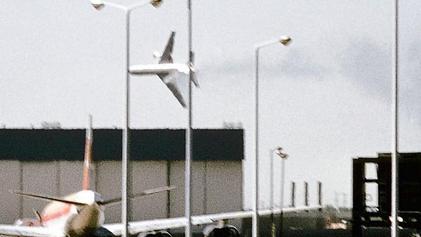As per yesterday's announcement, we're going to spend the summer going all around the city and explaining exactly why everybody makes such a big deal about Summertime in Chicago. But for today, we're going to take a slightly different track and chronicle the events that unfolded at O'Hare International Airport exactly 35 years ago today.
On May 25, 1979, people all across the country were getting ready for another calm and peaceful Memorial Day weekend filled with parades, grilling, drinking, and communing with peers. At O'Hare International Airport, Walter Lux was in the cockpit of a DC-10 prepping for yet another routine flight from Chicago to Los Angeles. Between Lux, his First Officer, and the Flight Engineer, the cockpit team had almost 5,000 hours flying experience on the DC-10.
8 weeks earlier, mechanics had been doing routine maintenance on that same aircraft when they performed a procedure on one of the plane's engines that involved removing the engine from the wing. There were two different ways of doing this. One involved taking the engine off of its pylon, and then removing the pylon from the wing. The other way involved removing the pylon with the engine still attached. The manufacturers of the DC-10 recommended the first method, but the second method was not without merit, as that involved fewer system disconnects to complete the procedure(which was gentler on the connections). Regardless, the mechanics working on that aircraft utilized the latter method.
Moving back to the 25th of May, the pilots have completed their pre-flight checks and the plane is now hurtling down the runway. All of a sudden, the engine underneath the plane's left wing breaks off of the aircraft and is flipped backwards over the wing. Many of the plane's systems begin to lose power as a result, rendering the plane in a good amount of trouble. As the plane was already at takeoff velocity, there was no turning back, and the plane left the ground. The flight crew saw that they had just lost an engine(though they had no way of knowing that the engine had literally fallen off), and initiated procedures to compensate for that. Alas, the procedures were not taking effect, and the aircraft climbed to a height of 300 feet while banking left at an angle of 112 degrees. For those of you who realize the extremity of that angle, you're right. In fact, this is what the plane looked like from O'Hare's observation deck in those final moments:
Soon after this photo was taken(and only 50 seconds after losing its engine), American Airlines Flight 191 crashed into a field near the corner of Touhy Avenue and Mount Prospect Road, erupting into a massive fireball. All 271 people onboard the aircraft as well as 2 people on the ground died. In the aftermath, the DC-10's reputation suffered as a result of the crash, as well as three other high-profile crashes from the 1970s. Ultimately, the DC-10 redeemed itself and continued to be used in passenger flights for the next 30+ years, before finally making its last passenger flight in February of 2014. The pylon-removal procedure(or more accurately, the shortcut method thereof) was eventually labeled the main cause of the engine snapping off. During that final maintenance stop, the pylon had been damaged, and 8 more weeks of takeoffs and landings had further exacerbated the problem until the stresses finally proved too much.
For the next several decades after the crash, there was no permanent memorial to those who lost their lives. That finally changed in 2011 when a 2-foot concave wall was erected 2 miles from the crash site listing the names of those who lost their lives in the crash. To this day, it remains the deadliest aviation accident to occur on United States soil(the September 11 attacks are not considered to be accidental)

No comments:
Post a Comment